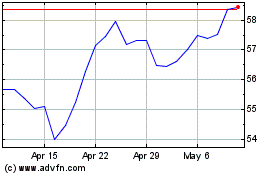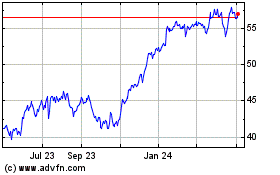Bank of New York Mellon Shares Fall as Bond Yields Dent Profits
April 17 2019 - 3:41PM
Dow Jones News
By Justin Baer
Bank of New York Mellon Corp. delivered a grim reminder that the
converging paths of bond yields can take their toll on the
financial-services industry.
Shares of BNY Mellon fell by nearly 10% in midday trading
Wednesday after the custody bank reported quarterly earnings and
revenue that fell short of Wall Street's expectations.
BNY Mellon's disappointing results underline how sensitive
financial firms can be to the ebb and flow of interest rates,
particularly when increases in short-term rates aren't matched with
rising longer-term rates. Last month, the yield on 10-year U.S.
government bonds fell below those of three-month Treasurys for the
first time since 2007 -- a so-called inverted yield curve that may
indicate a recession is lurking in the economy's future.
For banks and other financial firms that fund themselves with
deposits and other short-term loans and put that money to work
through loans and longer-term investments, a flattening yield curve
can squeeze their interest margins and leave a mark on earnings. At
BNY Mellon, net interest revenue fell 8% to $841 million from a
year earlier.
While Goldman Sachs Group Inc., Bank of America Corp. and other
big banks were able to sidestep the brunt of these effects,
custodians like BNY Mellon tend to lose clients' deposits faster as
rates go up. That's because commercial banks draw more of their
short-term funding from retail customers who are slower to pull
their money than big companies and institutions.
That's especially true for BNY Mellon, which tends to collect
more deposits that don't pay interest. As rates rose, more of BNY
Mellon's customers moved money out of the bank and into
interest-bearing deposits with a higher yield. That shift left BNY
Mellon with a bigger slice of their deposits drawing interest;
meantime, the average deposit rate rose from a year ago.
BNY Mellon and other custody banks don't have big lending
businesses, so a drop in deposits is usually with a decline in
securities holdings that generate interest income. So their revenue
from that interest was shrinking at the same time that their
interest margins were narrowing.
BNY Mellon "is suffering more than other firms now, and
certainly today is a stark reminder that there's an increasing
demand for yield," said Brennan Hawken, an analyst with UBS Group
AG. "You've got a double whammy on your hands."
BNY Mellon executives predicted in January that the bank's
net-interest revenue would be little-changed or slightly higher in
the first quarter from the last three months of 2018. Instead,
interest revenue fell 5%
"Rates across the entire yield curve declined versus our
assumptions, deposit balances declined, and we saw changes to the
mix between interest and noninterest-bearing deposits," Charles
Scharf, BNY Mellon's chairman and chief executive, said Wednesday
during a conference call with analysts. "We see significant
competitive pressure for deposits."
On the call, BNY Mellon finance chief Michael Santomassimo said
the bank expected deposit rates would "inch up a little bit" in the
second quarter.
BNY Mellon reported net income of $946 million, or 94 cents a
share, in the first quarter, down 19% from a year earlier. Total
revenue slipped 6.7% to $3.9 billion.
Analysts polled by S&P Global Market Intelligence had
expected a profit of 96 cents a share, on revenue of $4
billion.
BNY Mellon said the fees it collects also fell, dropping 9% to
$3.03 billion.
The bank's results were hurt by changes to currency exchange
rates and the flow of assets from its investment-management
division. The sale of several asset-management businesses last year
also affected the most-recent quarter.
Assets under management dropped 1% from a year ago, to $1.84
trillion.
On the call, BNY Mellon executives said they were continuing to
look for ways to trim expenses even as they invest heavily in
technology initiatives they expect will boost growth.
Noninterest expenses fell 1% to $2.7 billion in the first
quarter from a year earlier.
Allison Prang contributed to this article.
Write to Justin Baer at justin.baer@wsj.com
(END) Dow Jones Newswires
April 17, 2019 15:26 ET (19:26 GMT)
Copyright (c) 2019 Dow Jones & Company, Inc.
Bank of New York Mellon (NYSE:BK)
Historical Stock Chart
From Mar 2024 to Apr 2024

Bank of New York Mellon (NYSE:BK)
Historical Stock Chart
From Apr 2023 to Apr 2024
